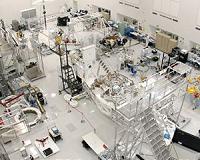 |
Washington DC (SPX) May 17, 2011 NASA has announced its first four payloads to fly on commercial suborbital spacecraft, kicking off a new era of low-cost technology R and D, science, and STEM education enabled by new commercial spacecraft being developed by Armadillo Aerospace, Blue Origin, Masten Space Systems, Virgin Galactic, and XCOR Aerospace. NASA also announced the latest round of payloads to fly on the Zero-G parabolic aircraft operated by Zero Gravity Corporation. NASA's suborbital payloads announcement illustrates the high-payoff projects being pursued by NASA's Office of the Chief Technologist (OCT), a newly formed division whose purpose is to revitalize technology R and D at NASA through innovative research. The Commercial Spaceflight Federation welcomes the strong support for space technology investments and the Office of the Chief Technologist in the NASA FY2012 proposed budget, including such high-profile programs as Commercial Reusable Suborbital Research, Centennial Challenges, and NASA's commercial parabolic flight program. Other exciting NASA technology programs being supported by the agency include Cryogenic Propellant Transfer and Storage, In-Space Propulsion, Space Power Generation and Storage, Nuclear Systems, Lightweight Materials and Structures, Human-Robotic Systems, Autonomous Systems, Next-Generation Life Support, Adaptive Entry Systems, and In-Situ Resource Utilization. CSF Executive Director John Gedmark stated, "Technology R and D is vital to NASA's future. The Office of the Chief Technologist, under the leadership of Dr. Robert Braun, is pushing the frontiers of technological achievement and perfectly embodying the "can-do" spirit of NASA. The Commercial Spaceflight Federation is proud to be able to support such programs. We look forward to continuing to work with OCT and NASA's other divisions as the space agency pursues breakthrough technologies in this new decade." Commenting on NASA's suborbital payloads announcement, Dr. Alan Stern, chair of the CSF's Suborbital Applications Researchers Group (SARG) and Associate Vice President with the Southwest Research Institute, said, "This really is great news for the commercial suborbital industry, and for the research community as well. NASA's announcement of some of its own first payloads that it will be flying to space on new commercial vehicles, with many more in the pipeline, is a good first step and is welcomed by researchers and technologists alike. The low cost and high flight rates of these vehicles are a real game-changer, and the benefits of these vehicles for education, science, and technology R and D are going to be substantial. Bravo to NASA for taking this first concrete step forward." NASA's Flight Opportunities Program, which consists of the Commercial Reusable Suborbital Research (CRuSR) Program and the Facilitated Access to the Space Environment for Technology Development and Training (FAST) Program, announced that the following four payloads will be flown this year (2011) on suborbital spacecraft, either by Masten Space Systems or by Armadillo Aerospace: + "Investigation to Determine Rotational Stability of On-Orbit Propellant Storage and Transfer Systems Undergoing Operational Fuel Transfer Scenarios" from Embry-Riddle Aeronautical University, Daytona Beach, Fla., NASA's Kennedy Space Center, Fla., and United Launch Alliance, Centennial, Colo.; Sathya Gangadharan, project manager (PM) + "Printing the Space Future" (3D printing/manufacturing technology) from Made In Space Inc., Moffett Field, Calif.; Jason Dunn, principal investigator (PI) + "Electromagnetic Field Measurements on Suborbital Launch Vehicles" from Johns Hopkins University's Applied Physics Lab, Laurel, Md.; Todd Smith and Lars Dyrud, co-PI + "Precision Landing Exploration Technology (PLANET) Demonstration" from Charles Stark Draper Laboratory, Inc., Cambridge, Ma., and NASA's Johnson Space Center, Houston; Douglas Zimpfer, PM; Tye Brady, PI The first two payloads listed above will also fly on the Zero Gravity Corporation's Zero-G parabolic aircraft, as will twelve other payloads also listed in NASA's announcement that will fly on the parabolic Zero-G aircraft.
Share This Article With Planet Earth
Related Links Commercial Spaceflight Federation (CSF) Space Tourism, Space Transport and Space Exploration News
 JPL Facility has Built Famed Spacecraft for 50 Years
JPL Facility has Built Famed Spacecraft for 50 YearsPasadena CA (JPL) May 13, 2011 The Spacecraft Assembly Facility of NASA's Jet Propulsion Laboratory in Pasadena, Calif., was constructed in 1961 to support NASA's Ranger and Mariner missions to the moon, Venus and Mars. America had entered the Space Age just three years earlier, with the launch of the JPL-built Explorer 1 spacecraft. The Spacecraft Assembly Facility, also known as JPL Building 179, originally had ... read more |
|
| The content herein, unless otherwise known to be public domain, are Copyright 1995-2010 - SpaceDaily. AFP and UPI Wire Stories are copyright Agence France-Presse and United Press International. ESA Portal Reports are copyright European Space Agency. All NASA sourced material is public domain. Additional copyrights may apply in whole or part to other bona fide parties. Advertising does not imply endorsement,agreement or approval of any opinions, statements or information provided by SpaceDaily on any Web page published or hosted by SpaceDaily. Privacy Statement |